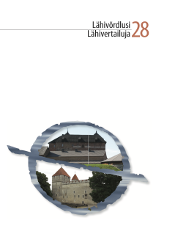“Koska ajattelit leikata ittes?” Ruotsin kielen vaikutus kaksikielisten nuorten suomen kieleen Haaparannalla ja Tukholmassa
Linguistic influence of Swedish on Finnish in informal conversations among bilingual adolescents in Haparanda and in Stockholm
Author(s): Jaana KoluSubject(s): Language studies, Foreign languages learning, Syntax, Present Times (2010 - today)
Published by: Eesti Rakenduslingvistika Ühing (ERÜ)
Keywords: language contact; cross-linguistic infuence; code-switching; borrowing; Sweden-Finns; Tornedalen; L2; bilingualism; Sweden; Finnish;
Summary/Abstract: Te focus of this paper is on Swedish influence on bilingual adolescents’ Finnish in informal group and pair conversations in Haparanda and Stockholm. Te theoretical framework is found in the fled of language contact research, especially earlier cross-linguistic influence studies. Te primary data was video- and audio-recorded in 2014–2017 from bilingual adolescents at three junior high schools in Haparanda and the secondary data was collected in 2015–2016 at two Swedish-Finnish junior high schools in Stockholm. All the recordings were made outside lesson times. Te analysis of the collected conversation data is qualitative and contrastive. Our earlier studies have shown that most of the embedded Swedish nouns and verbs in code-switching were adapted to the Finnish morphological system and to Finnish syntax, and the words were integrated into the Finnish grammatical system by declination, infection and conjugation. Only adjectives and adverbs were uninterested into the Finnish grammar. Nevertheless, Swedish words were not incorporated into the Finnish phonological frame in the data from Haparanda and Stockholm. Te results of this study show that Swedish influence on the bilingual adolescents’ Finnish takes place mainly in the lexicon and semantics. In addition to code-switching and borrowing, the semantic influence of Swedish on Finnish was shown in forms with Swedish idiomatic content owing to literal translations. Te corpus of conversations contains semantic influence from Swedish words with two Finnish counterparts. In those cases, a shift of meaning occurs during which the one Finnish word additionally takes on the semantic content of the other word (semantic extension). Overall, the adolescents’ spoken Finnish in Haparanda and Stockholm displays very little syntactic influence from Swedish shown in non-standard and incorrect forms in their informal conversations in Finnish. In sum, cross-linguistic influence is a complex phenomenon and bilinguals’ language repertoire is not made up of two distinct and autonomous languages that could be linearly and separately acquired and used.
Journal: Lähivőrdlusi. Lähivertailuja
- Issue Year: 2018
- Issue No: 28
- Page Range: 178-206
- Page Count: 29
- Language: Finnish

